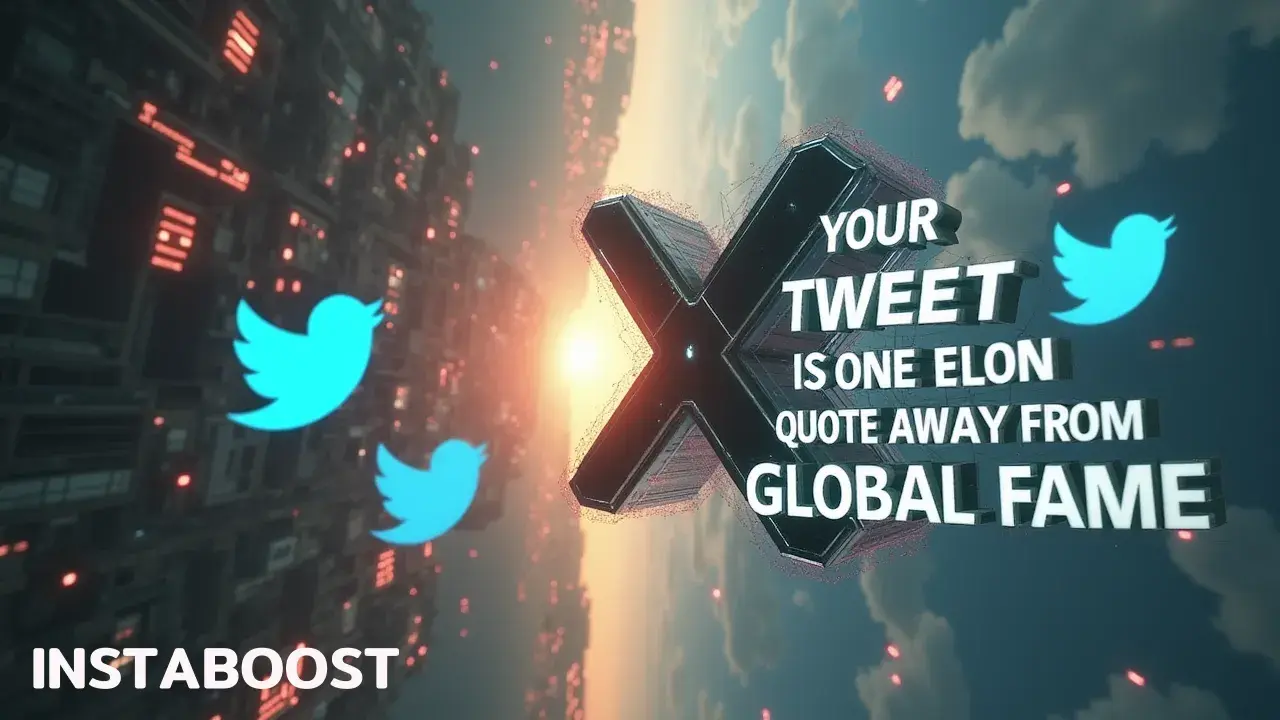Is Your Tweet One Elon Quote Away From Global Fame Or Shame?
Viral exposure can hinge on a single high-profile quote amplifying the right tweet. Clear context, intent, and timing increase the odds that the first hour delivers a measurable bump that can snowball. Monitoring early traction helps distinguish algorithmic surges from everyday timeline behavior and guides pacing for steady reach. Aim for crisp setup and track that initial momentum to balance dependable growth with room for lightning strikes.
The Retweet Roulette You Didn’t Mean to Play
Your tweet isn’t only a message; it’s something small that can land in the wrong place at the wrong time. On X, where Elon Musk’s quotes and boosts can send anything wide, a throwaway joke to friends can show up in front of strangers and read like a statement, a callout, or an opinion you didn’t mean to plant a flag on. That’s the setup of the platform: you talk to your circle, but the machine is tuned for spectacle.
People with big followings sit close to the power switch, and when they look your way, it doesn’t just widen the audience – it can tilt the meaning as it moves. The algorithm says it surfaces what matters to you, but your feed often tells you it’s more interested in fights, novelty, and clean storylines. When a post leaves your corner and gets pulled into the broader attention economy, context drops off, the crowd changes, and what you meant gets sliced into different readings. Virality isn’t only more views; it’s more interpretations, more agendas picking up your words, more side effects. That’s why some posts turn into Rorschach tests: they leave enough open space for people to project, they’re easy to clip into a quote-tweet, and they land in the middle of an argument that was already hot.
If you’re trying to keep your notifications from melting down, it helps to think of engagement not as a high score but as a steering wheel that other people can grab. This piece looks at how clout, boosts, and timing line up; how a single quote-tweet can bend your post into unfamiliar shapes; and how to think through upside versus blowback before a note to friends becomes a trending topic. Call it the retweet lottery. The odds are low, the outcomes are messy, and the fine print is your name hanging off it all and gain followers on Twitter whether you wanted them or not.

Receipts, Not Vibes
I learned this while cleaning up someone else’s mess. A client cracked a six‑word joke to friends, a power user saw it, and it ricocheted into the global feed. By the time I got there, we were sifting through stitched headlines, out‑of‑context screenshots, and a queue of takes. What helped wasn’t a polished apology; it was showing our work. We pulled exact timestamps, the first replies, and the surrounding thread, then walked through how one boost changed the read at each step. That’s how credibility works on X: receipts outrun rhetoric.
If your post is one quote‑tweet away from being everywhere, you need audit trails in place before anything takes off. Think like an editor: would a stranger, without your tone or history, understand it? Keep the claim specific, link the source, show the receipt, and avoid phrasing that can be clipped into a different argument. The feed rewards spectacle, but reputations hold up on verifiable detail.
Treat every post like something that will be searched, embedded, and read without you in the room. When the virality lottery hits, you want traceable intent, not a loose vibe that can be cut into a scandal. Keep a living “about” pin and a steady habit of sourcing; when things get noisy, your prior consistency becomes your reference point, and a link tossed in for context – say, to a stray mention like buy followers for x – can become the kind of breadcrumb that’s misread if you haven’t left the rest. Crisis comms isn’t magic – it’s metadata and restraint. In a feed that flattens context, your best defense is leaving a breadcrumb trail that lasts longer than the pile‑on. It feels fussy until you need it, and then it’s the only thing you’ve got and that’s the lesson I keep returning to.
Pre-Commit Filters Beat Post-Crisis Fixes
The best strategies always feel obvious after the mess. I try to treat every draft like it could get the Elon-quote treatment and write for that worst-case audience. I start with two quick checks: context and consequence. Context is a single line that sticks to the post – a clear frame, a source, or a note that survives a screenshot. Consequence is asking, “If strangers who don’t like me see this, what’s the most damaging misread?” Then I take away the easy mistakes: no vague “they,” no in-jokes that only friends will get, no numbers without a link or a citation. I trade vibes for verifiable details: link the source, include the stat, say where and when it applies.
If it’s a joke, I mark the target and set the tone so a global feed won’t treat it like a policy claim. I keep a simple risk scale: low (banter), medium (opinions), high (claims). For medium and high, I do a 30‑second friction check – would I stand by this if it hit trending? If not, I turn it into a thread with more context, wait until I can post it clearly, or move it to a place that isn’t easy to search. Timing matters. X rewards speed; your name rewards patience.
I try to post in daylight, not on adrenaline. I keep a short “pinch-hitter” reply saved with links and screenshots in case attention floods in and someone flips the lights on. And when I’m not sure, I ask a question instead of staking a take – curiosity holds up better under quote-tweets. This isn’t about silencing yourself; it’s about writing posts that can live through the machine. If one quote can push your tweet into global view, the timeline is a distribution channel, not a judge – and those pre-commit checks are the only guardrails you get, especially in the attention economics era where speed keeps winning until it doesn’t… and instant delivery likes on X is exactly the kind of shortcut that tempts people to move fast when they should slow down.
The Algorithm Isn’t Inevitable; It’s Predictable
I used to be optimistic, and then I looked at the analytics. Power users don’t create virality; they direct it. X’s boost mechanics make sense once you stop blaming “the internet” and start counting the levers: who quote-tweeted you, how polarized their audience is, and whether your post reads like a stance. That isn’t fate; it’s a decision tree.
So the pushback to the myth of randomness matters: if your tweet is one Elon quote away from global reach or pile-on, the responsible move isn’t to stay quiet – it’s to read the instruments. Trim ambiguity and the outrage angles shrink. Drop the stray proper noun and you dodge trend-scrapers looking for newsbait. Add a single sentence of framing and you can nudge replies from dunking to discussion. It’s dull work, which is why most people skip it.
But it works because the algorithm rewards velocity, and velocity rewards certainty. If your line can be screenshotted without the paragraph around it, assume it will be. The practical move is to pre-bake the screenshot: put the premise, the boundary, and the intended context in one pane. That shifts you from inkblot to receipt. In crisis work, I learned the “global feed” is really layers of micro-feeds with the same incentives. Treat the first three amplifiers – one fan, one critic, one aggregator – as your real audience.
Write for their worst read, not your best intentions. That isn’t giving in; it’s taking control. You can’t outvote the timeline, but you can starve it of misreads. And yes, search matters: people will Google your handle with “apology” or “explanation.” Give them a linkable, timestamped version before they go looking and Twitter video views are the kind of crude proxy that will frame that story for people who never saw the original post.
Ship Like It’ll Be Screen‑shotted
It won’t be perfect, but it should be honest. If one quote can send your tweet everywhere, the only durable approach is to build a publishing habit you can stand behind when it’s pulled out of context and frozen on a slide. Treat X like a searchable archive, not a vanishing feed. Write drafts you’d be okay seeing in a team deck, without your voice, next to someone else’s take. Those earlier “pre-commit filters” become muscle memory here: what’s the context, what are the consequences. The algorithm isn’t destiny; it’s regular enough to plan around.
Before you post, run three checks. Screenshot risk: does it make sense on its own if someone shares just the image? Misread risk: is there a straightforward way a reasonable person could take the worst reading because you left a gap? Amplification risk: what happens if a polarizing account quote-tweets it and it jumps into a hostile audience? This isn’t sanding off your ideas. It’s tightening the joints so they hold up when exported.
Counterintuitively, that makes you braver. When you’ve pressure-tested a stance, sudden reach feels less like being on trial and more like distribution. And if the pile-on comes anyway, you already have a plan: don’t delete in panic, add one clear note of context, then point attention to something worth seeing – the source, the full thread, a correction. That shifts attention from slot machine to air traffic control. The ending isn’t “go silent”; it’s “ship with receipts.” If the internet wants a Rorschach test, give it one with clear edges, so the shape people see is the one you meant to draw and order tweet retweets without mistaking volatility for validation.
The Moment Before the Megaphone
Your tweet isn’t a lottery ticket; it’s a fuse. On X, reach feels random until you trace the handoffs: one quote from the right power user can turn a throwaway line into a public hearing. I’m not saying this to scare you into silence, but to move from vibes to instrumentation.
The system isn’t mystical; it responds to things like how much disagreement a post invites, how close you are to high-status accounts, and whether your wording gives people something to push against. That’s why a quote from someone like Elon can turn your mentions into a wall of inkblots: a huge, split audience and a platform that rewards confidence more than nuance. So the question isn’t “What if I go viral?” but “What happens when my post is read by people who don’t like me, don’t get me, and don’t owe me context?” This piece walks that ground.
We’ll show how boosts actually work, why “ship like it’ll be screenshotted” is practical craft, and how to write posts that can handle a hostile quote without sanding off your point. We’ll treat X as a searchable archive, not a disappearing feed, and weigh clout against collateral damage with a clear view of the attention economy, noting how some creators even buy exposure for X posts as a variable in the turbulence. If you care about your timeline’s health, your reputation, or your sleep, think of this as flight school for sudden virality: preflight checks, common turbulence, and how to land when a quote turns an inside joke into global fame – or shame.















